- Prelude
- Editorial
- Interpretation of Antiquities and Art Treasure Act
- Jawahar Sircar
- Dr. Gautam Sengupta: Director General ASI
- Preserve our Heritage
- In Camera: An Unobtrusive Gaze of the Filmmaker's Journey
- A look into the Patna Museum
- Museums of Madhya Pradesh: An Overview
- A Collection of Museums and a Museum for Collectors (Museum & Galleries at Chitrakala Parishath, Bangalore)
- Discovery: Andhra Paintings of the Ramayana
- An Art work can be Reproduced not the Antique
- Hazarduari Palace Museum: One of the 7 wonders of India
- The Silken Embroidery of Antique Collection
- Khuddur Jatra: a transformation from literature to art and back to literature
- India Art Festival A Preview
- Warping the Modernist Space: Stylistics of Postmodern Architecture
- Vintage Radio
- Sekhar Roy
- Who's afraid of AATA and what is it afraid about?
- China's rise and India's place
- What Happened and What's Forthcoming
- Art Events Kolkata: April – May 2011
- The more the merrier
- Mumbai Art Sighting
- North East Opsis
- Art Bengaluru
- Musings from Chennai
- Previews
- In the News
ART news & views
Vintage Radio
Volume: 3 Issue No: 17 Month: 6 Year: 2011
Collectibles
by Anurima Sen
In order to understand the fascination that a vintage radio holds for a collector, one must realize the importance of the golden age of the radio- roughly spanning from the 1920s to the 1950s. An entire generation was mesmerized, with millions of radios being churned out by manufacturers in the United States.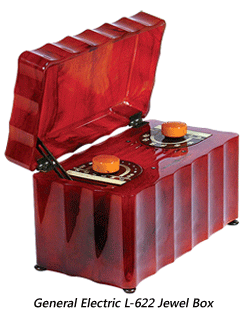 It is estimated that in 1930, about 12 million US households owned a radio and by another decade, the number escalated to 28 million! It was no longer sufficient for radios to be just functional in offering entertainment to the family unit- they soon evolved into being statement pieces of one's household.
It is estimated that in 1930, about 12 million US households owned a radio and by another decade, the number escalated to 28 million! It was no longer sufficient for radios to be just functional in offering entertainment to the family unit- they soon evolved into being statement pieces of one's household.
The major manufacturing companies were RCA, Philco, Zenith, GE, Stromberg-Carlson, Eico, EF Johnson, National, Heathkit, Hammarkund, and Lafayette among various others. Collecting antique radios today is not just another nostalgia-driven hobby, but a vocation that demands a lot of attention. Enthusiasts need to gather these radio pieces, either restore them or preserve them, and master the construction techniques that were in vogue back then. The vast majority of the manufacturing companies have long since vanished, but many of the sets produced in those three decades remain scattered all over the world. The easiest way to search for these radios is to haunt garage sales, flea markets and antique shops- but one may need to persevere in order to restore these radios to their former glory. One saving grace is that most of the components and supplies required for the restoration of antique radios are still easily available- for example, the vacuum tube. Modern consumer electronics do not resemble these vacuum tubes anymore. One of the major drawbacks of these tubes was that they degraded very fast- usually requiring replacement once in every two or three years. 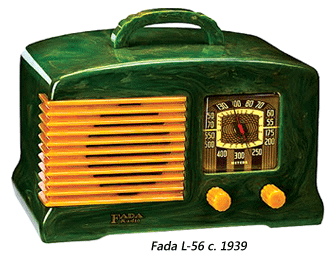 The other requirements for bringing a radio back in shape are capacitors and resistors- both of which are still being manufactured. It has to be kept in mind that even though identical parts cannot be procured at all points of time, equivalent parts can act as excellent substitutes. Most collectors are against the idea of completely sprucing up the look of a vintage radio- a worn, used look imparts an old-world charm to the set that modern equipments thoroughly lack. A quick search on the World Wide Web would reveal several sources that deal in constituent products such as knobs and grille cloth aiding in a complete restoration of the radio's appearance. There also are repairing shops that would undertake the entire process of restoring a vintage radio on a collector's behalf.
The other requirements for bringing a radio back in shape are capacitors and resistors- both of which are still being manufactured. It has to be kept in mind that even though identical parts cannot be procured at all points of time, equivalent parts can act as excellent substitutes. Most collectors are against the idea of completely sprucing up the look of a vintage radio- a worn, used look imparts an old-world charm to the set that modern equipments thoroughly lack. A quick search on the World Wide Web would reveal several sources that deal in constituent products such as knobs and grille cloth aiding in a complete restoration of the radio's appearance. There also are repairing shops that would undertake the entire process of restoring a vintage radio on a collector's behalf.
Vintage radios can be classified under many heads, such as Breadboard, Cathedral, Chairside, Console, Portable, Table, Tombstone, Clock-radio and Novelty radio:
The Breadboard is one of the earliest radios with the vacuum tubes and other component parts attached to a rectangular board which has “breadboard” ends; these radios have no covers, their components remain completely exposed. Cathedral radios or 'beehives' as they are popularly known, 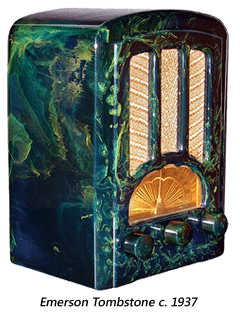 get their name from their tall stature. The top is usually a rounded peak, akin to a cathedral window. A chairside radio is typically small in size, with its controls on the top. A console radio, also known as a 'floor model' consists of a cabinet (with or without legs) which is rectangular in shape and sits directly on the floor. A portable radio is smaller in size in comparison to all models listed above and runs on both electricity and battery power in most cases. The term 'table' radios is used to denote certain radios that are tabletop sets, while tombstone radios get their name from their shape (alternatively called 'upright table models'). The term clock-radio is self explanatory- it refers to those models which incorporated a clock in their overall design. Other uniquely designed models fall into the category of novelty radios, for example there are collectible models with unusual cases sporting Mickey-Mouse, or models that have an inbuilt camera, or models that have been designed to resemble a bottle, a baseball and so on. The case-material of these vintage radios is a major contributing factor to their pricing. Primarily, there were cloth, wood, metal and plastic cases. Certain cloth designs were made to look like leather or snakeskin, which led to their popularity. Cases made of “Catalin” plastics, vividly coloured like the Bakelite, were pricier than most others. A kind of pressed wood, Repwood, used widely in the 1930s for decorative purposes was used to make elaborate radio cases as well. As far as the reception of these radios were concerned (i.e. those designed for consumer use), there were four main categories: Broadcast (BC) which is synonymous with the Amplitude Modulation (AM) band that exists till this day.
get their name from their tall stature. The top is usually a rounded peak, akin to a cathedral window. A chairside radio is typically small in size, with its controls on the top. A console radio, also known as a 'floor model' consists of a cabinet (with or without legs) which is rectangular in shape and sits directly on the floor. A portable radio is smaller in size in comparison to all models listed above and runs on both electricity and battery power in most cases. The term 'table' radios is used to denote certain radios that are tabletop sets, while tombstone radios get their name from their shape (alternatively called 'upright table models'). The term clock-radio is self explanatory- it refers to those models which incorporated a clock in their overall design. Other uniquely designed models fall into the category of novelty radios, for example there are collectible models with unusual cases sporting Mickey-Mouse, or models that have an inbuilt camera, or models that have been designed to resemble a bottle, a baseball and so on. The case-material of these vintage radios is a major contributing factor to their pricing. Primarily, there were cloth, wood, metal and plastic cases. Certain cloth designs were made to look like leather or snakeskin, which led to their popularity. Cases made of “Catalin” plastics, vividly coloured like the Bakelite, were pricier than most others. A kind of pressed wood, Repwood, used widely in the 1930s for decorative purposes was used to make elaborate radio cases as well. As far as the reception of these radios were concerned (i.e. those designed for consumer use), there were four main categories: Broadcast (BC) which is synonymous with the Amplitude Modulation (AM) band that exists till this day.  The BC covered from around 550 kilohertz, or kilocycles as it was then called, to 1600 kilohertz. Frequency modulation (FM) was a type of reception and frequency range that evolved prior to the Second World War. Back then it covered the range between 42-50 megacycles. In 1945, the FM band as given its present day allocation of 88-108 MC. The Long Wave (LW) reception covered the range between 100 KC to 500 KC. And lastly there is the Short Wave (SW) covering the range from 1600KC to 30 MC which would result in showing foreign cities on the radio dial.
The BC covered from around 550 kilohertz, or kilocycles as it was then called, to 1600 kilohertz. Frequency modulation (FM) was a type of reception and frequency range that evolved prior to the Second World War. Back then it covered the range between 42-50 megacycles. In 1945, the FM band as given its present day allocation of 88-108 MC. The Long Wave (LW) reception covered the range between 100 KC to 500 KC. And lastly there is the Short Wave (SW) covering the range from 1600KC to 30 MC which would result in showing foreign cities on the radio dial.
Attaching a price tag to an antique radio is difficult. For example, a model that has been produced in large volumes, and is of average design will not enjoy much popularity in collectors' circles- but rarer and aesthetically unique sets sporting Art-Deco designs for example will tend to enjoy a tendency of ever increasing prices. While deciding upon the price of a vintage set there are several considerations- firstly, its current physical condition. In order to be highly priced, all of the knobs and tubes must be original, the tuning dials or scales should be complete and readable, and the component parts must remain intact. The cabinets, be of wood or plastic, must not be cracked or chipped while cloth covered cabinets should not be stained or heavily worn. Secondly, the electronic condition: this is impossible to judge in its entirety from just a visual inspection of the radio concerned. However, one should keep an eye out for signs of functional problems- such as overheating and burn-marks.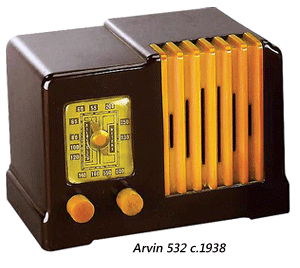 As aforementioned, restoring a radio to its original condition is no mean task, and is both expensive and time consuming. Thus, radios that are found in mint condition will have a very high pricing.
As aforementioned, restoring a radio to its original condition is no mean task, and is both expensive and time consuming. Thus, radios that are found in mint condition will have a very high pricing.
Coming back to vintage radios that are considered to be collectibles, catalin radios, as mentioned above is very much in demand. For example, there is the Addison A2 model (1940) in yellow and cherry red which has a ridged and flowing “waterfall” grille cover and small pinwheel knobs. The Air King A-600, or the Duchess, is also quite popular in collectors' circles because of its large and unique design. The front of the cabinet was cast in two separate pieces and then fastened to the main cabinet. It is maintained that the front panel and the large grille attachment were among the biggest cast-catalin parts ever attempted. There is also the Arvin 532 (1938); often called a “left-handed set” because its largish grill is located on the right, while the knobs are placed on the right. The set is mostly available in two combinations of colours: maroon with butterscotch trim and butterscotch with tortoise trim. The 1939 Automatic radio, called the Tom Thumb, also sports a Deco design. It has a very unique cut out grill, a rectangular dial face, and a horizontal knob placement. The sleek cabinet shape is also enticing with its smooth left curve and sharp right corner. This set was made available in a wide variety of colours such as azure blue, marbleized green and marbleized red. The non-deco version of the same model sports similar cut out grilles, with vertically positioned knobs. It was made available in orchid-pink, red, butterscotch, ivory, black and Nile-green among others. Other important models include the 1945 FADA radio 1000, Bullet; the 1940 Emerson models 400 Patriot and 400 Aristocrat; the 1937 Emerson Tombstone; the 1938 Halson A5 model;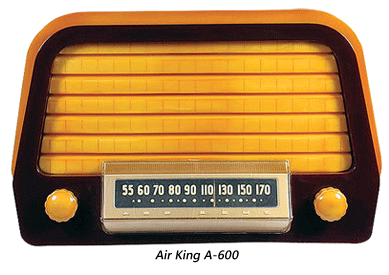 the General Electric L-622 Jewel Box; Majestic's popular Charlie McCarthy models; Bendix's sole model, the 526C (1946).
the General Electric L-622 Jewel Box; Majestic's popular Charlie McCarthy models; Bendix's sole model, the 526C (1946).
As far as auctions are concerned, in December 2010, Bonhams showcased over ninety table radios, and the top-seller was a brilliant red 1933 Air King 52 with a map-of-the-world dial. It was sold for $42,700. The radios auctioned belonged to the private collection of Michael and Diane Schoeman, and included a 1938 Emerson AX-235 which was bought at $15,860, a 1939 Fada L-56 which raked in $10,980 and a 1935-36 Spartain Bluebird 566 designed by Walter Dorwin Teague which was sold for $9,150. The reason why even non-functional radios from the 1930s- 1940s notch up high prices today at auctions is that they have become pieces of aesthetic beauty. These inspired creations not only sought to establish a link between the individual and the larger community, they also became statement pieces that reflected the age of both cultural and technological advancement.